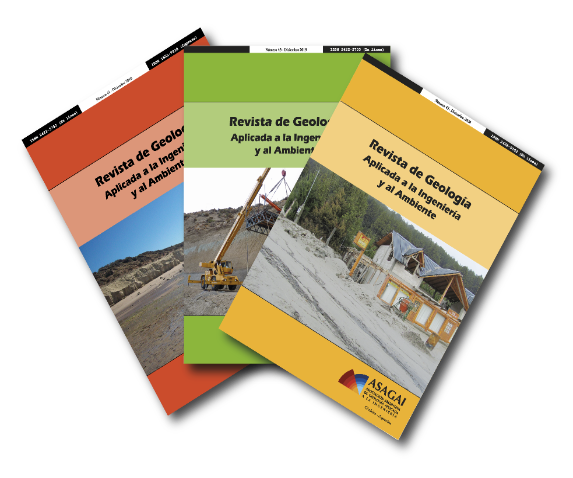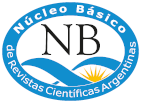Evaluación del riesgo geológico en la cuenca del arroyo El Salado, en el marco del desarrollo sustentable del departamento Iglesia, San Juan
DOI:
https://doi.org/10.59069/24225703ee018Palabras clave:
caudal, cuenca, ecosistema, vegetaciónResumen
La subcuenca del arroyo El Salado integra la red de drenaje del río Blanco, en el norte de la provincia de San Juan. Su cabecera se desarrolla en la cordillera de Colangüil, donde afloran areniscas de la formación Cerro Agua Negra, de edad Paleozoico superior, las que se hayan intruidas por las rocas graníticas del plutón Los Puentes, de edad Pérmico superior – Triásico inferior.
Esta cuenca tiene alimentación nival y pluvial, esta última menor a 100 mm anuales. Aproximadamente, la mitad del recorrido de su eje principal es sobre material moderno de aluvión. El área supera los 400 km2, con lo que posibilitaría una crecida extraordinaria mayor a 150 m3/seg. El material de aporte sólido, ante una crecida, se incorporaría en el segmento de base de la cuenca, donde predominan materiales tanto de terrazas y cauce fluvial como también de monte. Otro riesgo de importancia es el sísmico, por presentar eventos de alta intensidad en la distribución histórica de sismos para el noroeste argentino.
La cobertura de la vegetación, en un tramo del valle aluvial, exhibe una característica distribución de parches, constituidos predominantemente por: Larrea divaricata, Bulnesia retama y otro, de menor cobertura, de matorral de Proustia cuneifolia o mendocina. La superficie húmeda del cauce durante gran parte del año o, en su defecto, la baja profundidad del agua freática y el tipo de suelo con alta permeabilidad son aspectos que caracterizan el ecosistema de equilibrio para esta última especie y constituyen una guía de exploración hidrogeológica.
Referencias
Aguiar, Martín R. and Sala, Osvaldo E. (1999). Patch structure, dynamics and implications for the functioning of arid ecosystems. TREE vol. 14, no. 7 July 1999
Benavídez de Albar Díaz, M. (2016). Oro y plata en la historia minera de San Juan. Editorial UNSJ. ISBN 978-987-3984-22-8.
Bonvissuto, G.L. y Busso, C.A. (2006). Ascenso hidráulico en y entre isletas de vegetación en la zona árida de Argentina. ?YTON, Revista Internacional de Botánica experimental 75: 55-70.
Busquets, P., Méndez-Bedia, I., Gallastegui G., Colombo, F., Cardó, R., Limarino O., Heredia N. and Césari, S. N. (2013). The relationship between carbonate facies, volcanic rocks and plant remains in a late Paleozoic lacustrine system (San Ignacio Fm, Frontal Cordillera, San Juan province, Argentina). International Journal of Earth Sciences (Geol Rundsch) 102:1271–1287.
Cardó, R., I. Díaz, S. Poma, V. Litvak, G. Santamaría y Limarino, O. (2007). Hoja Geológica 2969-III Malimán, Provincia de San Juan, a escala 1: 250.000. Instituto de Geología y Recursos Minerales, SEGEMAR, Boletín 320, 52 pág., Buenos Aires.
Castro, C. E. (1987). El batolito de Colangüil entre las quebradas de la Pancha (30º latitud sur) y Agua Blanca (30º 16’ latitud sur). Geología y mineralización asociada. San Juan. Actas 10º Congreso Geológico Argentino, 4: 100 - 103. S. M. de Tucumán.
Destino San Juan (2020). https://mineriaydesarrollo.com/2020/08/03/fideicomisos-en-san-juan-que-se-hizo-y-se-hara-con-fondos-mineros/
Hoffman, J.A.J. (1975). Atlas climático de América del Sur, 1ra parte, Temperatura y Precipitación. UNESCO-OMN. Cartografía Budapest, Ginebra.
INPRES (2023). Registros históricos. http://contenidos.inpres.gob.ar/sismologia/linkppal
Instituto de Investigaciones Hidráulicas, UNSJ. (2001). Análisis de los impactos sociales, económicos, culturales y ambientales de la minería. Informe 3. Proyecto PASMA - Desarrollo Sustentable. Componente Ambiental San Juan. Inédito.
Instituto Nacional del Agua (2020). Mapas en línea de lluvias máximas diarias con recurrencia asociadas (PMD) y valor límite estimado para la República Argentina. Consultado el 7 de agosto de 2020.
Llambías, E.J. y Sato, A.M. (1990). El Batolito de Colangüil (29-31ºS), Cordillera Frontal de Argentina; estructura y marco tectónico. Revista Geológica de Chile, vol. 17, No. 1, 89-108. Servicio Nacional de Geología y Minería. Santiago, Chile.
Martínez Carretero, Eduardo (Ed.), (2007). Diversidad biológica y Cultural de los Altos Andes Centrales de Argentina. Línea de base de la reserva de biósfera San Guillermo - San Juan. Martínez Carretero, E. editor, 1a ed. San Juan; Univ. Nacional de San Juan. 284 p. 26x19 cm. ISBN 978-950-605-528-8
Mesa Permanente de la Gestión Integrada del Agua (2023). Gobierno de San Juan. https://hidraulica.sanjuan.gob.ar/normativas/lineamientos.php
Ministerio de Justicia y Derechos Humanos-Presidencia de la Nación (1999). Convenios
Muñoz M.R., Squeo, F.A., Leon M.F., Tracol, Y. and Gutierrez, J.R. (2008). Hydraulic lift in three shrub species from the Chilean coastal desert. Journal of Arid Environments 72 (2008) 624–632.
NRCS, “National Engineering Handbook Hydrology Chapters” (2015), (En línea). Recuperado el 8 de junio de 2022. Disponible en: http:// www.nrcs.usda.gov/wps/portal/nrcs/detailfull//
Perucca, P. L. y Bastías H. E. (2005). El Terremoto Argentino de 1894: Fenómenos de Licuefacción asociados a Sismos. En: Aceñolaza F. G. et al. (Eds.) INSUGEO, Serie Correlación Geológica, 19: 55-70. Tucumán. IBSN 1514-4186 - ISSN on-line 1666-9479
Polanski, J. (1958). El bloque varíscico de la Cordillera Frontal de Mendoza. Asociación Geológica Argentina, Revista 12 (3): 165-196. Buenos Aires.
Regairaz, M. C. (1996). Clasificación Taxonómica de Suelos; San Juan. Inventario de Recursos de La Región Andina Argentina. Junta de Andalucía, Gobiernos y Universidades de la Región Andina.
Reynolds, James F., Paul R. Kemp, Kiona Ogle and Roberto J. Fernández (2004). Modifying the ‘pulse–reserve’ paradigm for deserts of North America: precipitation pulses, soil water, and plant responses. Oecologia (2004) 141: 194–210 - DOI 10.1007/s00442-004-1524-4
Servicio Informático Gobierno de San Juan. https://sisanjuan.gob.ar/interes-general/2019-10-15/18050-san-juan-y-su-variada-flora-autoctona
Servicio Informático Gobierno de San Juan. Obtenido el 5/10/2020. https://sisanjuan.gob.ar/planificacion-e-infraestructura.
Servicio Informático Gobierno de San Juan, Turismo y Cultura, (2021). https://sisanjuan.gob.ar/turismo-y-cultura/2021-05-14/31968
Tiempo de San Juan (2014). tiempodesanjuan.com/terremoto-1894-68612.html www.todo-argentina.net
United States Geological Survey. Earth Explorer. Obtención de Imágenes Satelitales de descarga gratuita https://earthexplorer.usgs.gov/
Van Wambeke, AR and CO Scoppa. (1976). Las taxas climáticas de los suelos argentinos (Determinación de las definiciones del Soil
Taxonomy, utilizando el modelo matemático de Newhall y computación Fortran). Revista de Investigaciones Agropecuaria (RIA-INTA). Serie 3: Clima y Suelos XIII 1: 7-39.
Ven te Chow, Maidment, David R. and Mays, Larry W. (1994). Hidrología Aplicada. Ed McGraw Hill (1Ed).
Wetten, Aníbal. F., Vargas Luna, Germán y Wetten, Paula A. (2022). Características hídricas de una cuenca de alta montaña y aptitudes de la vegetación como mecanismo de ascenso hidráulico. Departamento Iglesia, provincia de San Juan. XI Congreso Argentino de Hidrogeología. Bahía Blanca, Argentina.
Descargas
Publicado
Número
Sección
Licencia
Derechos de autor 2024 Aníbal Wetten

Esta obra está bajo una licencia internacional Creative Commons Atribución-NoComercial-CompartirIgual 4.0.
Atribución – No Comercial – Compartir Igual (by-nc-sa): No se permite un uso comercial de la obra original ni de las posibles obras derivadas, la distribución de las cuales se debe hacer con una licencia igual a la que regula la obra original.










